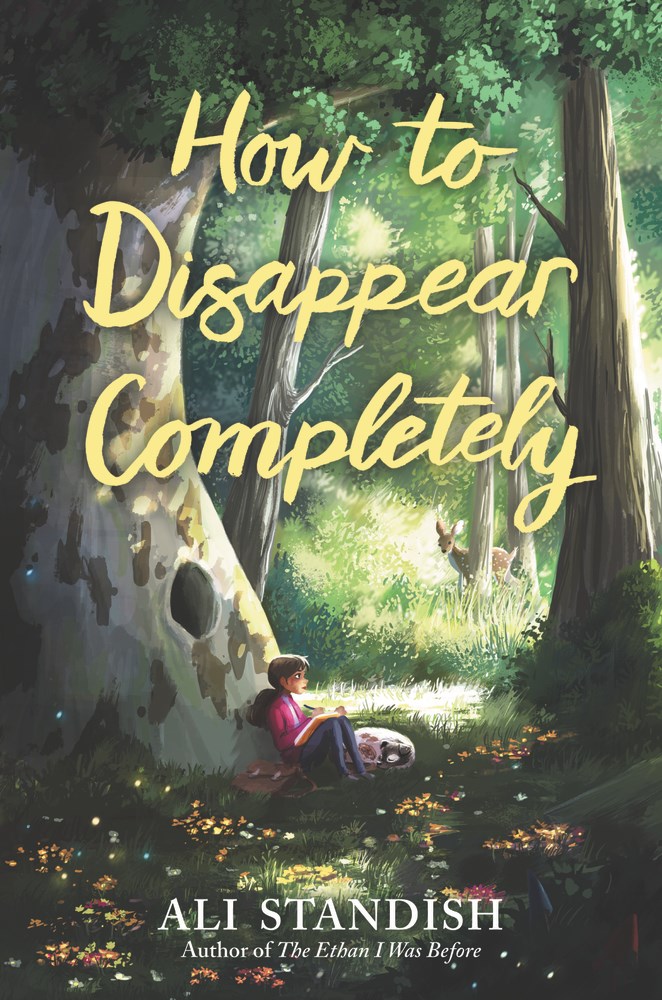 Targeting ‘tweens, How to Disappear Completely by Ali Standish is an interesting novel about difference, not only about how we treat others who are different but the ways our own differences can empower us and even transform us into more than we thought we could be. It is also a book about navigating junior high school and about coping with death.
Targeting ‘tweens, How to Disappear Completely by Ali Standish is an interesting novel about difference, not only about how we treat others who are different but the ways our own differences can empower us and even transform us into more than we thought we could be. It is also a book about navigating junior high school and about coping with death.
Set in Lanternwood, a town with the feel of stepping back in time, the plot revolves around twelve-year-old Emma Talbot who has just lost her grandmother, who is also her best friend. With Gram, Emma had lived in a world “made of old books and warm milk and sprinkled with fairy dust. A world where Gram could fix anything with a twinkle of her eye” (73).
But now that Gram is gone, the magic spell has broken and Emma is not sure if Gram’s advice can fix anything in the world in which she now lives—a world with bullies like Edie O’Shea and flawless older sisters who are good at noticing the outsides of people and conditions like vitiligo that change the skin’s pigmentation and make a person the target of misunderstanding and mockery. Emma misses her grandmother so deeply that she aches both physically and emotionally.
When Emma begins to notice white spots on her skin, she initially covers them up with socks, long sleeves, and bangs, but when they no longer stay confined to places where they can be covered up, her mother notices, and the medical appointments begin. With people speaking Science instead of English, Emma soon feels more like a lab rat or a problem to be solved than a seventh grade girl. Her life becomes about light treatments, sun-screen, special creams, and make-up. Although she wants to be Emma, the girl who reads a lot and hangs out with her friends, she becomes the girl with vitiligo, a freak and a bully’s target.
Stuck on the dark and lonely side of a wall, Emma begins to feel sorry for herself and grows depressed, pushing her friends away and thinking it is better to be invisible than a freak.
With the help of her best friend Josefina Ramirez, who is “extremely weird in an extremely awesome way” (121) and by recalling advice from her gram: “People are always afraid of things they don’t understand, darlin’. . . . Being afraid is easy; it’s understanding that takes work” (45), Emma gradually steps out from behind her wall of depression.
Standish tells her story with numerous allusions to fairy tales and occasionally even makes it a parallel tale to The World at the End of the Tunnel by R. M. Wildsmith, a tale which turns out to have a mystery of its own.
Ultimately, How to Disappear Completely makes some astute observations about human nature and gives advice to readers of all ages about how we cannot change what people think of us, nor can we control whether they call us names or write mean notes. After all, something is only true when we believe it is, and sometimes we have to fight to see the real truth.
Emma has to decide whether she is unique, brave, and beautiful or a freak; whether she wants people to see the color she puts into the world or the color that has been taken from her skin.
Readers also learn that not every story has a happy ending and that the truest part of a fairy tale is that there will always be a battle. And the ending is always better if we’re willing to fight for what we believe and if we’re willing to fight for ourselves. Through Emma, we also discover that when we change the way we see, we potentially change who we are.
Finally, Standish leaves the reader to wonder about magic and whether fairy tales are real. Under the influence of her pen, the reader is enchanted, charmed, and transformed into believing that magic is all about how we see things.
- Posted by Donna

